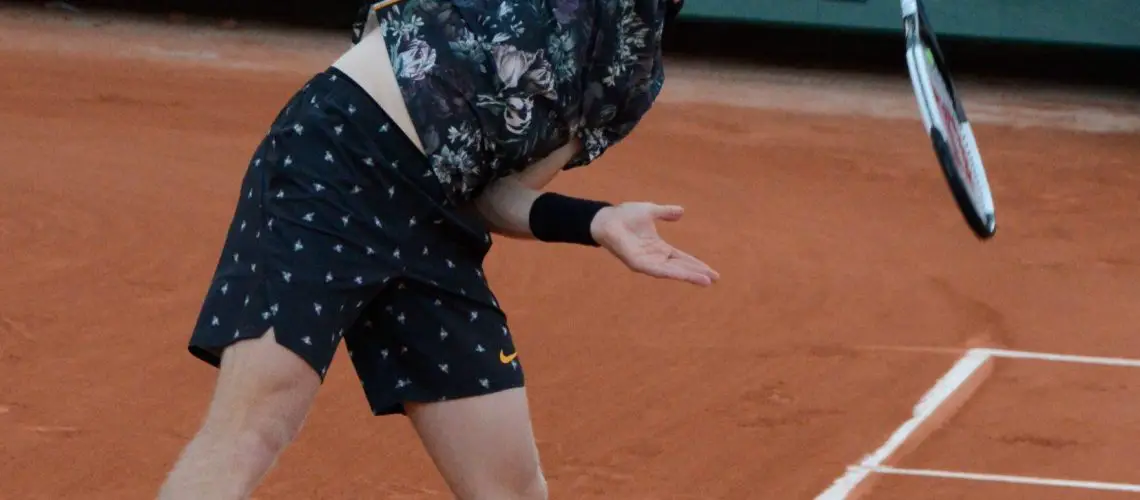We may earn money or products from the companies mentioned in this post.
Introduction

When it comes to tennis, the surface on which the game is played can greatly impact the dynamics of a match Different surfaces offer varying levels of speed and bounce, which in turn affect players’ strategies and gameplay Understanding the nuances of these surfaces is crucial for both professionals and enthusiasts alike In this blog post, we will delve into the world of tennis surfaces, exploring their significance and examining the factors that contribute to their speed Our ultimate goal? To determine which surface reigns as the fastest in the game
A Brief Overview of Tennis Surfaces
Tennis is played on a variety of different surfaces, each with its own unique characteristics The most common types include grass, clay, hard court (such as acrylic or asphalt), and carpet Each surface presents its own challenges and advantages, making it essential for players to adapt their game accordingly
The Importance of Understanding Different Surfaces in Tennis
A deeper understanding of different tennis surfaces allows players to tailor their playing style to better suit specific conditions For instance, grass courts tend to favor aggressive play due to their fast-paced nature and low bounce On the other hand, clay courts are known for being slower with higher bounces, prompting players to adopt more defensive strategies
Factors Affecting the Speed of a Tennis Surface
Several factors influence how fast or slow a tennis surface plays These factors include court materials, such as grass or clay composition; court preparation techniques like rolling or watering; weather conditions like temperature and humidity; and even altitude levels at certain locations
The Purpose of This Blog Post
In this blog post, our main objective is to compare various tennis surfaces and determine which one holds the crown as the fastest playing surface in tennis By analyzing key elements such as ball speed off the ground, bounce height, and player mobility on each surface type, we aim to provide an insightful evaluation that will shed light on the unique characteristics of each surface
So, whether you’re a tennis enthusiast looking to deepen your knowledge or a curious player seeking to optimize your game strategy, join us in this exploration of tennis surfaces Get ready to discover which surface reigns supreme in terms of speed and how it can impact the outcome of matches at all levels of play
Types of Tennis Surfaces and Their Characteristics

Grass Courts
Grass courts, with their lush green surfaces, have a rich history in tennis They provide a unique playing experience characterized by low bounce and fast ball movement The natural grass surface offers players a challenge as they need to adjust their footwork due to the unpredictable nature of the court Wimbledon, known as the most prestigious tennis tournament, is played on grass courts
Clay Courts
Clay courts come in different types such as red clay and green clay (also known as Har-Tru). These surfaces offer distinctive characteristics that set them apart from other tennis courts With high bounce and slower ball movement, clay courts demand patience and strategic play from players The French Open, held at Roland Garros Stadium in Paris, is renowned for its red clay court
Hard Courts
Hard courts are widely popular among professional players due to their versatility and durability There are various types of hard courts including acrylic, synthetic, asphalt, and concrete surfaces These courts offer a medium level of bounce and allow for varying ball movement speeds depending on the materials used in their construction The US Open held in New York City and Australian Open held in Melbourne are two major tournaments played on hard courts
By understanding the characteristics of different tennis surfaces, players can adapt their game strategies accordingly Whether it’s the slickness of grass or the slower pace of clay, each surface presents its own set of challenges for athletes to overcome So next time you watch a thrilling match on TV or step onto a tennis court yourself, take note of how these different surfaces influence gameplay dynamics!
Methods for Determining Court Speed

When it comes to tennis, the speed of the court can greatly impact the dynamics of a match Determining the court speed accurately is essential for players and organizers alike In this article, we will explore two main methods for determining court speed: measuring ball rebound height and player perception and experience
Measuring Ball Rebound Height
One of the most common ways to assess court speed is by measuring the ball rebound height This method involves conducting drop tests where a ball is dropped from a specific height onto different areas of the court surface
-
How it works:
The drop test measures how high the ball bounces back after hitting the surface By comparing these rebound heights, an average can be calculated, which gives an indication of how fast or slow the court is -
Drop tests:
These tests involve dropping a tennis ball from a predetermined height onto various spots on the court, such as near or on each baseline and service line -
Court pace rating system:
Based on the results obtained from drop tests, a court pace rating system can be established This rating system categorizes courts into different speed categories, ranging from slow to medium to fast courts
This method has its advantages and limitations On one hand, measuring ball rebound height provides quantitative data that can be used in a standardized manner across different courts On the other hand, it may not fully capture certain aspects like variations due to weather conditions or player styles
Player Perception and Experience
In addition to objective measurements, player perception and experience also play a crucial role in determining court speed
-
How player style affects perceived speed:
Different players have different playing styles, and each player may perceive the court speed differently based on their preferences and strengths For example, a player with a powerful serve might find a slower court more challenging, while a player who excels in long rallies may prefer a faster court -
Subjectivity vs objectivity in determining court speed:
While objective measurements provide valuable data, it is important to consider the subjective element as well Players’ experiences and perceptions can offer insights into how the court feels during gameplay, which cannot be solely captured through scientific measurements
In conclusion, determining court speed involves both objective measurements and subjective player experiences Measuring ball rebound height through drop tests and establishing a court pace rating system provides standardized data, while considering players’ perception and experience offers valuable insights into how the court behaves during gameplay By utilizing both methods together, an accurate assessment of court speed can be achieved
Comparison and Analysis: Which Surface Is The Fastest?

When it comes to the speed of a tennis court, three main surfaces come to mind: grass courts, clay courts, and hard courts Each surface offers a unique playing experience, but which one can be considered the fastest? Let’s delve into a direct comparison based on ball rebound height measurements and average serve speeds at major tournaments for each surface type
Grass Courts vs Clay Courts vs Hard Courts
One way to assess the speed of a tennis court is by measuring the ball rebound height Grass courts typically yield lower ball rebound heights compared to clay or hard courts This means that the ball bounces closer to the ground, making it more challenging for players to react quickly On clay courts, however, the softer surface allows for higher ball rebound heights due to its ability to absorb some of the impact
In terms of average serve speeds at major tournaments, hard courts often take the lead The harder surface provides a faster and more predictable bounce, enabling players to generate more power in their serves Grass courts also offer fast-paced games with quick serves due to their low bounce characteristics
External Factors Influencing Court Speed
The speed of a tennis court can be influenced by various external factors as well Weather conditions play a significant role in determining court speed For instance, on hot and dry days, clay courts tend to become faster as they dry out and harden On the other hand, rainy conditions can slow down all types of surfaces
Court maintenance and upkeep also have an impact on court speed Regular watering or rolling of grass courts can affect their pace by either slowing them down or making them faster depending on how it is managed Similarly, on clay courts where regular grooming occurs through brushing and rolling, the speed can be adjusted accordingly
Conclusion

Based on the collected data and analysis, it is clear that hard courts generally offer the fastest playing experience in terms of ball rebound height and average serve speeds at major tournaments However, it’s important to note that court speed can vary depending on external factors such as weather conditions and maintenance Ultimately, players’ preferences and playing styles also come into play when determining which surface suits them best
Closing Thoughts

In conclusion, the ability to adapt to different surfaces in competitive tennis is crucial for any player aiming to achieve success on a variety of courts Whether it’s the slow clay courts that demand patience and precision or the fast-paced hard courts that require quick reflexes and powerful shots, being able to adjust one’s game accordingly is key By understanding how court speed affects ball movement and bounce, players can develop strategies that exploit their opponent’s weaknesses and capitalize on their own strengths
Furthermore, comprehending court speed not only enhances a player’s performance but also shapes their overall strategy A slower surface may favor defensive tactics, such as longer rallies and well-placed shots, while a faster surface may encourage aggressive play with shorter points and powerful serves Being able to gauge the pace of a court allows players to make informed decisions on shot selection, footwork, and positioning, ultimately giving them an edge over their opponents
Useful Links

Types of Tennis Courts【Dimensions, Types…】
Tennis Court Surfaces and Court Speeds – Perfect Tennis
What Is The Slowest Surface In Tennis? – The Racket Life
How Different Is It To Play The Various Tennis Court …
Fastest Tennis Surface
The Reason Why Wimbledon Is the Fastest Tennis Surface
Types of Tennis court surfaces
What Are Tennis Courts Made Of? (The 11 Surfaces)
Tennis Court Surface: Pros And Cons Of The Different …
Surface speed – Heavy Topspin
Explore the 4 Types of Tennis Courts, From Clay to Synthetic
4 types of surfaces you will see in Tennis
New hard court tennis surface scores with high durability
Analysis Of The 4 Different Tennis Surfaces [2023 Guide]
What Surface Is Fastest In Tennis?
Comparing the Court Speeds at Wimbledon and the U.S. …
Are Court Surfaces Slowing Down the Game? Does It Matter?
Choosing a Tennis Surface
The Most Challenging Tennis Surfaces and Their Effect on …
Everything you need to know about tennis courts






